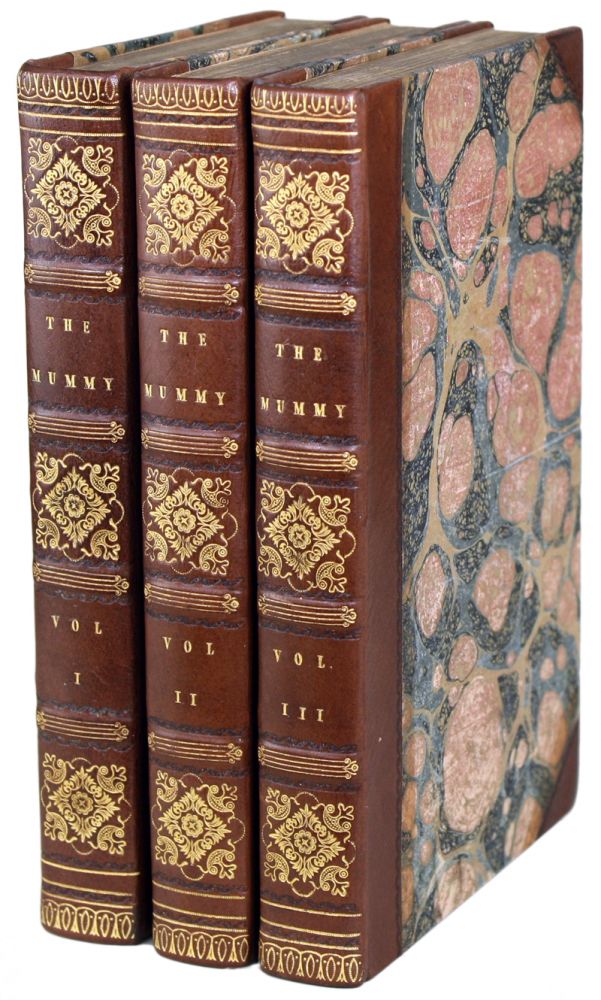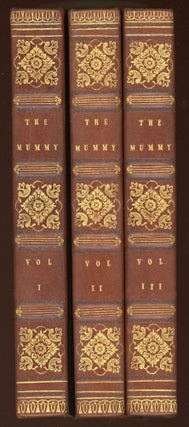THE MUMMY! A TALE OF THE TWENTY-SECOND CENTURY ... Second Edition. London: Henry Colburn, 1828. 12mo, three volumes: pp. [i-iii] iv-viii [1] 2-309 [310: blank]; [i-ii] [1] 2-331 [332: blank]; [i-ii] [1-2] 3-311 [312: printer's imprint], rebound in eighteenth-century style three-quarter leather and marbled boards, spine panels lettered and richly tooled in gold. Second edition, revised. The text of second edition, also published anonymously, differs substantially from that of the 1827 first edition (see Locke, Spectrum II, p. 131). THE MUMMY is one of the three most important British science fiction novels published during the early nineteenth century, the others being Mary Shelley's FRANKENSTEIN and THE LAST MAN, and, according to Alkon, the novel is "one of the two most noteworthy English efforts between FRANKENSTEIN and the scientific romances of H. G. Wells" (Science Fiction Before 1900, p. 38). An "exuberant Gothic romance ... which ... described the technological wonders of the twenty-second century; steam mowing apparatus, balloons that rise to a height of seventeen miles and mobile houses that move from place to place on railway lines. Her prophecy of the new Egypt makes her the first sibyl in the history of modern technology." - Clarke, The Pattern of Expectation: 1644-2001, pp. 55-6. "One of the children of FRANKENSTEIN, interesting in its curious medley of themes from current events, literature, and social theory. It contains snippets of almost every popular fictional form of its period and the immediate past, and also anticipates future developments. It offers utopian thought, Gothicism, anti-intellectualism, Egyptological discoveries, fantastic inventions, memories of Napoleon, Byronism, a dynastic theory of history, and much else ... The SF element is strong, with many inventions and many projections of history; the supernatural element enters in the background, in the ultimate anti-intellectual theme, when the mummy reveals that it was not really revived by electricity, but by God as a warning against scientific prying." - Bleiler, The Guide to Supernatural Fiction 1205. The "novel focuses primarily on the Byzantine political intrigues in an England under a female monarchial succession. In this advanced world of the future, where weather control is possible and people travel in high-speed balloons, a man named Edric journeys to Egypt -- now totally industrialized -- with a Frankensteinian plan for reanimating the mummy of Cheops. The attempt appears successful, but afterwards Edric passes out and the mummy escapes, taking Edric's balloon to England and entering into the plotting and counter-plotting there. Thereafter, the romance reads more like something out of Sir Walter Scott. In the final scene [in] the Cheops' tomb, the mummy, who has for the most part been presented as a diabolic figure, reveals to Edric that supernatural rather than natural forces caused him to come to life again temporarily to 'assist the good and punish the malevolent' as penitence for his misdeeds as pharaoh." - Anatomy of Wonder (1976) 1-24. "Webb's novel, despite the originality of a future setting which deserves very high praise, remains a comic fable without either tragic force, mythic power, or the sustained cognitive and emotional interest that may be achieved by scientifically plausible marvels of the kind Felix Bodin was soon to associate with futuristic fiction. Webb's achievement nevertheless commands respect and deserves far more recognition than it has received precisely because THE MUMMY does come remarkably close to meeting Bodin's standards. It best illustrates the incomplete evolution of futuristic fiction up to the 1830s. It also best illustrates how far an effort to sustain metafictional self-consciousness in a tale shaped by the dictates of fantasy rather than realism could serve as encouragement for creating a futuristic fiction. Writing neither as a prophet nor a utopian but in an explicit effort to invent a new kind of hero in a new kind of fiction, Jane Webb almost achieved the ideal novel of the future as Bodin was to define it [in LE ROMAN DE L'AVENIR (1834)] only seven years later." - Alkon, Origins of Futuristic Fiction, pp. 231-41. Following this 1828 edition, the full text of THE MUMMY was reprinted once, a one-volume cheap edition published by Frederick Warne & Co. in 1872. The only modern edition is abridged. Anatomy of Wonder (2004) II-1218. Bleiler, Science-Fiction: The Early Years 2313. Bleiler, in The Arkham Sampler (Spring, 1949), pp. 17-24. Clarke, Tale of the Future (1978), p. 3. Clute and Nicholls, eds., The Encyclopedia of Science Fiction (1993), p. 736. Locke, A Spectrum of Fantasy, p. 18 and A Spectrum of Fantasy Volume II, p. 131. Negley, Utopian Literature: A Bibliography 708. Schlobin, The Literature of Fantasy 680. Sargent, British and American Utopian Literature, 1516-1985, p. 40. Bleiler (1978), p. 126. Reginald 09229. Block, The English Novel 1740-1850, p. 143. See Garside, Raven and Schöwerling 1827: 50. Not in Sadleir or Wolff. Some mild scattered foxing to the text block, but basically a fine copy. (#152141).
Price: $12,500.00
"SECOND EDITION" on title pages.



